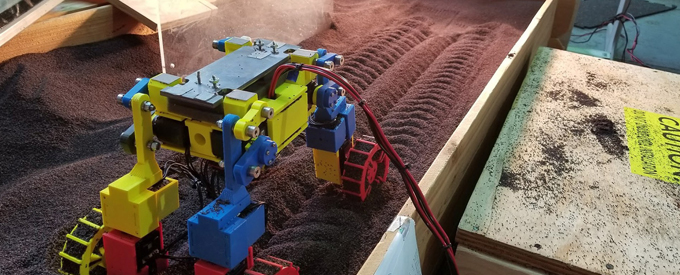2020-06-07
Clever New Robot Rover Design Masters Sand Traps
Built with liftable wheeled appendages, a new robot rover developed with U.S. Army funding benefits from complex locomotion techniques permitting it to climb sand covered hills without getting stuck. The roving robot has attracted NASA’s attention for potential surveying of the Moon or a planet.
The rover’s behaviour is modelled on a branch of physics known as ‘terradynamics’. According to Georgia Institute of Technology researchers, the Mini Rover robot uses rear rotator pedaling to climb a slope in a design that combines paddling, walking and wheel-spinning motions.
As part of the U.S. Army Combat Capabilities Development Command’s Army Research Laboratory and NASA, the Army Research Office (ARO) funded the research through the National Robotics Initiative. “This basic research is revealing exciting new approaches for locomotion in complex terrain,” said Dr. Samuel Stanton, an ARO Programme Manager. “This could lead to platforms capable of intelligently transitioning between wheeled and legged modes of movement to maintain high operational tempo.”
Researchers at the Dunn Family Professor in the School of Physics at the Georgia Institute of Technology are focusing on one problem for the robot – movement on loose materials like sand flow. “This rover has enough degrees of freedom that it can get out of jams pretty effectively,” confirmed project scientist Dan Goldman. “By avalanching materials from the front wheels, it creates a localised fluid hill for the back wheels that is not as steep as the real slope. The rover is always self-generating and self-organising a good hill for itself.”
A Remarkable 4-wheeled Robot
The robot built by NASA’s Johnson Space Centre has pioneered the ability to spin its wheels, sweep the surface with those wheels and lift each of its wheeled appendages to create a broad range of potential motions. Georgia Tech researchers used in-house NASA 3-D printers to re-create those capabilities in a scaled-down vehicle with four-wheeled appendages driven by 12 different motors.
“The rover was developed with a modular mechatronic architecture, commercially available components and a minimal number of parts,” reported Siddharth Shrivastava, an undergraduate student in Georgia Tech’s George W. Woodruff School of Mechanical Engineering. “This enabled our team to use our robot as a robust laboratory tool and focus our efforts on exploring creative and interesting experiments without worrying about damaging the rover, service downtime or hitting performance limitations.”
The rover’s broad range of movements gave the research team an opportunity to test multiple variations using the science of granular drag force measurements and modified Resistive Force Theory. The team began by testing the gaits explored by the NASA RP15 robot then experimented with locomotion schemes impossible to test on a full-size rover.
Solving the Gait Problem
The researchers trialled their experimental gaits on slopes designed to simulate planetary and lunar hills. To evaluate the role of tilting in controlling the granular substrate, they utilised a fluidised bed system known as SCATTER, or Systematic Creation of Arbitrary Terrain and Testing of Exploratory Robots.
This new robotic gait allowed the rover to climb a steep slope with the front wheels stirring up the poppy seeds used as granular material for the lab testing, then pushing them back towards the rear wheels. The rear wheels wiggled from side-to-side, lifting and spinning to create a motion resembling paddling in water.
The material pushed to the back wheels changed the slope that the rear wheels needed to climb. This process allowed the rover to make steady progress up a hill that might have stopped a simple wheeled robot.
“In our previous studies of pure legged robots, modelled on animals, we had figured out that the secret was to not make a mess,” confirmed project researcher Goldman.
“If you end up making too much of a mess with most robots, you end up just paddling and digging into the granular material. If you want fast locomotion, we found that you should try to keep the material as solid as possible by tweaking the parameters of motion.”
For some time, the issue has been that simple motions are problematic for Mars rovers stuck in granular materials. According to Goldman, this gait discovery may now help future rovers avoid the same fate.
“This combination of lifting and wheeling and paddling, if used properly, provides the ability to maintain some forward progress even if it is slow,” Goldman said. “Through our laboratory experiments, we have shown principles that could lead to improved robustness in planetary exploration – and even in challenging surfaces on our own planet.”
The researchers next hope to scale up the unusual gaits to larger robots within the context of studying robots and their localised environments together.
Although the Mini Rover was designed to study lunar and planetary exploration, these lessons could also be applicable to terrestrial locomotion in an area of interest to the U.S. Army.
Reference Text/Photo:


No Comments